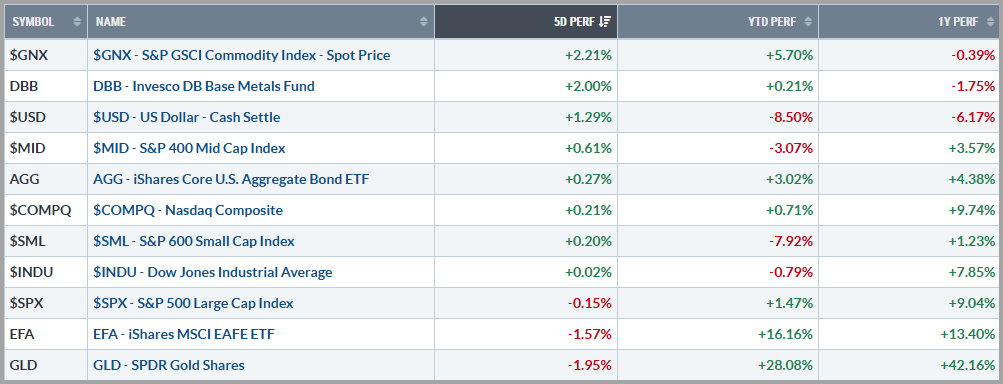Stocks Waver as Middle East Risks Resurface and Fed Stays Cautious
Stocks kicked off last week on a strong note, as easing tensions in the Middle East helped push the S&P 500 back toward multi-month highs. Investors were encouraged by Iran’s willingness to re-engage in nuclear talks and by soft economic data that hinted the Federal Reserve might soon consider easing interest rates. By mid-week, however, that momentum faded as geopolitical risks re-emerged and the Federal Reserve struck a more hawkish tone during their June policy meeting, as they implied the likelihood of keeping interest rates higher for longer, to attempt to ensure inflation continues to cool amidst the tariff backdrop.
Economic data continued to reflect a gradually slowing U.S. economy, but not one headed for recession (there is a fine line there…). Retail sales declined slightly, seemingly largely due to lower gas and auto spending, but the underlying figures (excluding certain volatile categories) showed consumer spending remained relatively resilient. That’s important given how critical consumer activity is to overall economic growth.
When all was said and done, the major stock indices closed the week mixed, but relatively flat, with the benchmark S&P 500 closing near the middle of its 3-week trading band. Bonds were not too surprised with any of the happenings last week as yields traded in a tight range while the US dollar got a modest bump from the Fed’s lack of urgency to lower rates. Commodities were a bit more volatile given the escalating Middle East tensions and trade war concerns.

Source: stockcharts.com
The Week Ahead — All eyes on inflation, Fed signals, and global headlines
As we head into the final full week of June, markets will likely remain on edge following this past weekend’s U.S. airstrikes on Iran’s nuclear facilities. While tensions remain high, investors are watching closely to see whether the situation escalates or stabilizes. Any signs of further conflict or retaliation could drive short-term volatility in markets.
On the economic front, the spotlight will be on Friday’s release of the Personal Consumption Expenditures (PCE) inflation report, the Federal Reserve’s preferred inflation gauge. If inflation continues to cool, it could reinforce expectations for interest rate cuts later this year. We may also hear from several Fed officials throughout the week, which could provide more insight into the timing and likelihood of future rate adjustments. After last week’s slightly more cautious (or “hawkish”) tone from the Fed, investors will be keying in on any clues that could shape sentiment.
Beyond inflation and Fed speak, markets will be digesting consumer confidence data and housing numbers, offering additional clues about the strength of the U.S. economy. So far, data has suggested a soft but steady economic environment, not strong enough to delay potential rate cuts, but not weak enough to raise serious recession concerns.
Tying it all together:
Markets are currently walking a fine line. The economic data we’ve seen lately paints a picture of a soft but steady environment as growth is slowing, but not enough to spark recession fears. At the same time, it’s not strong enough to take rate cuts off the table. The Federal Reserve has left interest rates unchanged, but recent comments from officials suggest they remain open to easing policy later this year, especially if inflation continues to trend lower. That outlook has helped support equity markets, which currently remain near multi-month highs.
The labor market continues to be a relatively bright spot. While job growth has cooled somewhat from last year’s pace, unemployment remains low, and wage pressures have moderated without falling off a cliff. This “not too hot, not too cold” dynamic is giving the Fed more flexibility with enough economic strength to avoid a downturn, but not so much that it risks reigniting inflation. Still, the Fed is walking a narrow path, and any surprises in inflation or employment data could shift the outlook quickly.
At the same time, stock market valuations remain elevated, reflecting a high level of investor confidence, or perhaps complacency. Despite ongoing geopolitical risks, tariff and trade war concerns, and an uncertain Fed timeline, sentiment remains relatively optimistic. The market seems to currently be pricing in a near-perfect scenario where inflation continues to fall, the labor market remains strong, the Fed starts cutting rates, and the economy avoids a recession. While that outcome is possible, it leaves little room for error.
Looking ahead, we see both risks and opportunities. On the one hand, volatility could pick up if the current narrative begins to change. On the other hand, a stable labor market and easing inflation pressures could create a supportive environment for well-positioned portfolios. In this kind of landscape, staying diversified, focusing on quality, and remaining flexible and adaptive as the backdrop emerges has consistently served investors well.
Please feel free to share these commentaries and, should you have any questions regarding your current strategy or the markets in general, please reach out to your CIAS Investment Adviser Representative.
Important Disclosures:
Past performance is not indicative of future results. This material is not financial advice or an offer to sell any product. The statements contained herein are solely based upon the opinions of Edward J. Sabo and the data available at the time of publication of this report, and there is no assurance that any predicted or implied results will actually occur. Information was obtained from third-party sources, which are believed to be reliable, but are not guaranteed as to their accuracy or completeness.
The actual characteristics with respect to any particular client account will vary based on a number of factors including but not limited to: (i) the size of the account; (ii) investment restrictions applicable to the account, if any; and (iii) market exigencies at the time of investment. Capital Investment Advisory Services, LLC (CIAS) reserves the right to modify its current investment strategies and techniques based on changing market dynamics or client needs. The information provided in this report should not be considered a recommendation to purchase or sell any particular security. There is no assurance that any securities discussed herein will remain in an account’s portfolio at the time you receive this report or that securities sold have not been repurchased. The securities discussed may not represent an account’s entire portfolio and in the aggregate may represent only a small percentage of an account’s portfolio holdings. It should not be assumed that any of the securities transactions, holdings or sectors discussed were or will prove to be profitable, or that the investment recommendations or decisions we make in the future will be profitable or will equal the investment performance of the securities discussed herein.
CIAS is a registered investment advisor. More information about the advisor, including its investment strategies and objectives, can be obtained by visiting www.capital-invest.com. A copy of CIAS’s disclosure statement (Part 2 of Form ADV) is available, without charge, upon request. Our Form ADV contains information regarding our Firm’s business practices and the backgrounds of our key personnel. Please contact us at (919) 831-2370 if you would like to receive this information.
Capital Investment Advisory Services, LLC
100 E. Six Forks Road, Ste. 200; Raleigh, North Carolina 27609
Securities offered through Capital Investment Group, Inc. & Capital Investment Brokerage, Inc.

